

UCity’s England Library closed, services moved to Griffith Hall
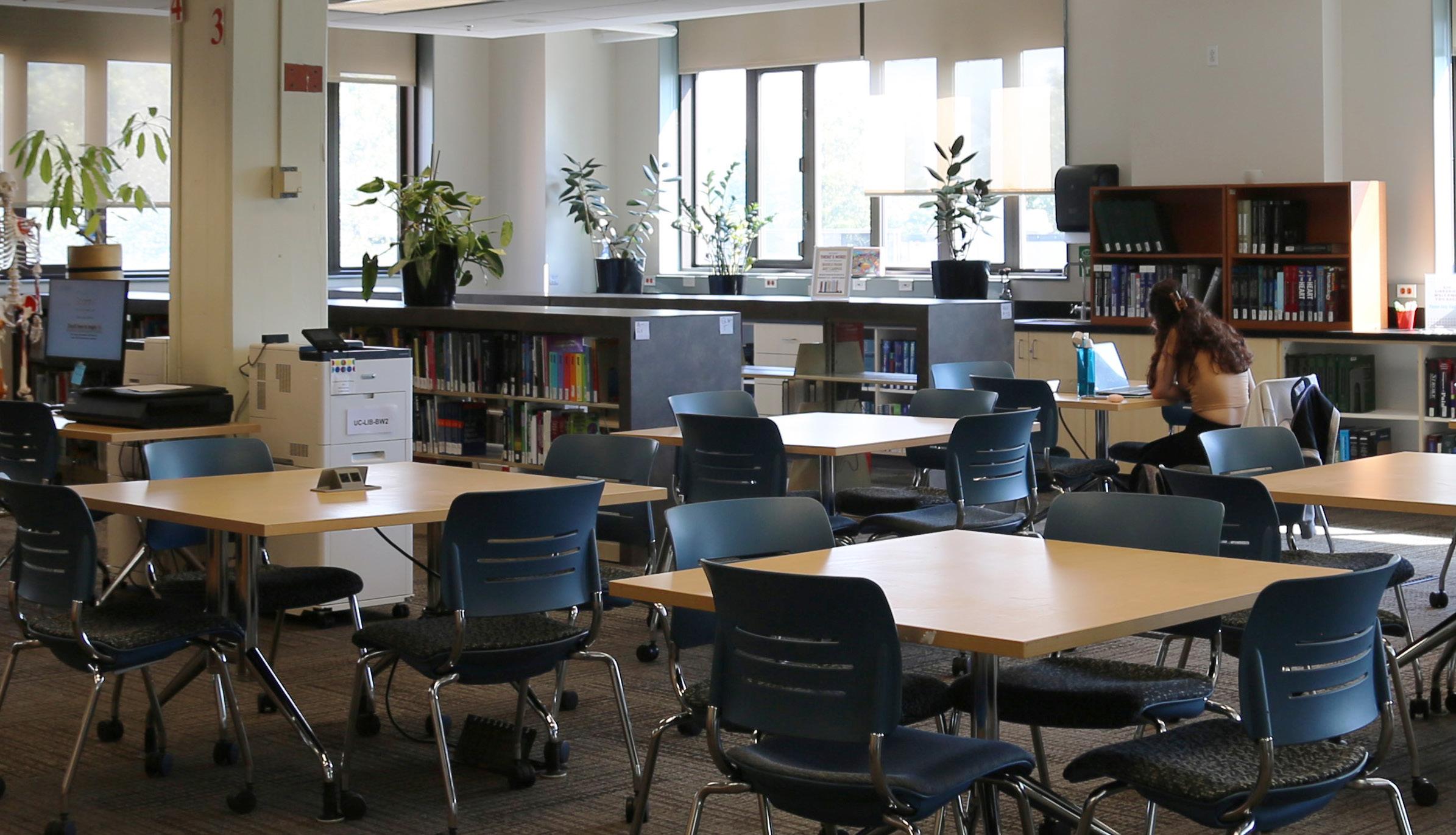
ALLY ENGELBERT ’25 Editor-in-Chief
Library services on the University City campus moved to Griffith Hall at the start of the fall semester, following the early closure of Joseph W. England Library due to air conditioning failures over the summer.
The Aug. 23 move was announced in a message from Anne Krakow, St. Joe’s library director, posted to the Saint Joseph’s University Libraries website Aug. 16. UCity students also received an email with the news from Jean McGivney-Burelle, Ph.D., provost and senior vice president of academic affairs, Aug. 19.
The new Griffith Library location was planned, set up and made ready for students in only about 60 days over the summer, said Hilda Wilson, building operations coordinator of the UCity location for Saint Joseph’s University Libraries.
“It was all hands on deck from everywhere, just making sure the library opens on time and the library is ready for its students when classes started,” Wilson said.
In January 2024, the university announced contingent plans to vacate England Library by the end of the 2024-2025 academic year. However, plans to move library services to Griffith Hall were “accelerated” due to the air conditioning issues, wrote Ken Ogawa, associate vice president of administrative services, in response to written questions from The Hawk.
“The entire building’s HVAC system would have to be replaced to restore full service to the building. Given the already planned closure of England Library, this was not practical,” Ogawa wrote.
Krakow’s message announcing the closure added, “On Sept. 30, we will reassess the situation to determine if the England Library can be reopened as an additional quiet study space for the remainder of the academic year.”
This decision to reopen England Library in some capacity depends on three things, Krakow said in an interview with The Hawk:
temperature, staffing and need.
Before its closure, England Library’s usage was on the decline, as previously reported in The Hawk. In the year from June 2022 to May 31, 2023, there were 100,504 gate entries into England Library. This decreased to 43,248 entries for the fall 2023 semester. Gate entries include library staff, faculty and students entering the library.
Numbers continued to decline in the spring 2024 semester. From January to May 2024, there were 39,588 gate entries to England Library, Wilson said.
While Griffith Library does not have a swipe or gate entry count, foot traffic counts taken by Wilson estimated 730 visitors to Griffith Library from Sept. 9 to Sept. 19. Wilson counted the number of visitors every 30 minutes from 8 a.m. to 5 p.m. The estimate of 730 visitors includes visitors counted multiple times if they remained in the library for multiple 30-minute periods.
Jen Hasse, head of access services and student experience for Saint Joseph’s University Libraries, said England Library was underutilized, and the new space in Griffith Hall reflects that.
“[Griffith Library is] everything that we had. It’s just less of it, but that matches the reduced population,” Hasse said. “England Library was pretty empty, it was not being used to capacity, so it feels like a more efficient use of resources.”
If England Library does reopen, it will be as a study building, with library services remaining in Griffith Library, Krakow said.
But having both spaces open may isolate students even more, Hasse said.
“If you’re spreading people out across this big campus, it makes everything feel really empty,” Hasse said. “Having this smaller, more central library space is bringing people here. We open up another space, are we then going to create a situation where there’s a handful of people here, a handful of people there? We want to be bringing people together so they feel like they’re on a vibrant campus.”
Carly Robinson ’26, PharmD ’28, said each floor of England Library “had a different feel to it,” and UCity students were worried this would be lost in a new location.
Archives Unboxed: England Library blueprints
LUKE SANELLI ’26 News Editor
For over 50 years, the Joseph W. England Library has stood as a landmark on St. Joe’s University City campus, formerly the campus of the University of the Sciences.
Completed in early October 1973, the building’s earliest history is rolled tight in a thin stack of blueprints bound by a rubber band into a fraying cylinder.
Unrolling the prints reveals each paper’s torn sides and edges, curled at the corners. The papers, held in St. Joe’s Archives Collection, are the color of coffee stains or khaki pants, reminiscent of colonial-era newspapers.
The illustrations themselves were drawn with thin, blue-gray lines under the supervision of Philadelphia architect Alfred Panepinto. They form perfect square boxes packed with words and measurements written out in neat, capital letters to represent reading lounges, information centers, elevators and book stacks.
“If you wanted to go with your friends and have a study room, there was an option for that. If you wanted to play games or use the craft storage stuff, there was a space for that. And if you wanted silence, there was room for that,” Robinson said. “People were really concerned about how that would transfer to another location on campus.”
Griffith Library, located in Griffith Hall, Suite 208, replicates the floors of England Library in a more condensed area. There are various reservable single and group study rooms, capturing the different noise levels of each floor. There is also a 24-hour silent study room open to all St. Joe’s students.
The main library space is outfitted with furniture+, shelving and decor taken directly from England Library. A collection of books fills the shelves and displays, along with anatomy models and leisure reading collections. Printers and computers are also available for student use.
Also affected by the closure of England Library were the UCity locations of the Writing Center and HawkHUB, St. Joe’s food and basic needs resource center.
“ENGLAND LIBRARY” CONTINUED ON PG. 2
The first blueprint, dated April 20, 1972, makes plans for the library’s apothecary jar display space on the first floor, which would feature some of the university’s collection of intricately decorated vessels created to store or mix herbs and powders.
The final blueprint, dated Nov. 2, 1972, was the floor plan for the library’s first floor.
Lesley Carey, archivist at Drexel Library, said it is important to hold on to relics from North America’s first pharmacy college, the Philadelphia College of Pharmacy, which changed its name to University of the Sciences in 1998.
“If they end up, in coming years, not having the building there, then it really is a record of what was there,” Carey said.
The England Library was scheduled to close in fall of 2025, per St. Joe’s Library Director Anne Krakow’s announcement to the Saint Joseph’s University Libraries website Aug. 16. The building’s malfunctioning air conditioning forced an early closure Aug. 23.
The university is scheduled to evaluate whether England can be reopened as a study area Sept. 30.
Carey said the library is a testament to the generosity of Joseph W. England and his daughter, Elizabeth England, who was one of the major donors to the library. Both Englands pursued careers in the medical field.
“[Elizabeth] was taught by her father, who was a pharmacist and instrumental in the founding and the continuing of the school, to be of service to others,” Carey said. “That’s, to me, a remarkable part of this building.”

Student Newspaper of Saint Joseph’s University
Aimee Della Porta honors those in recovery from substance use disorder.
SOPHIA GALANTE ’26 News Reporter
A student studies inside Griffith Library, Sept. 20.
PHOTO: MADELINE WILLIAMS ’26/THE HAWK
‘This becomes a place for exchanging ideas’
S. Ilan Troen speaks about different perspectives on Israel and Palestine
VINCENT KORNACKI ’25 Managing Editor
The Institute for Jewish-Catholic Relations held its first of three fall public programs, “Understanding Multiple Narratives about Israel/Palestine,” Sept. 16 in the Mandeville Hall Teletorium.
Co-sponsored by the Faith-Justice Studies Program, the event’s main speaker was S. Ilan Troen, Ph.D., an American-Israeli scholar and historian who spoke about how to understand the multiple complex narratives surrounding the relationship between Israel and Palestine.
Troen is professor emeritus of modern history at Ben-Gurion University of the Negev and professor emeritus of Israel Studies at Brandeis University. His presentation described the different religious and secular political narratives used to define the relationship between Israel and Palestine, particularly in reference to Israeli statehood.
Troen explained recognizing religion’s role, whether it is involved implicitly or explicitly, is key to understanding the history and relationship between Israel and Palestine.
“Total denial is absolutely inaccurate and wrong,” Troen said. “But what measure of recognition and how much weight to give to religion depends on situations and depends upon people at different times.”
Adam Gregerman, Ph.D., professor of theology and associate director of the Institute for Jewish-Catholic Relations, said through events like
‘We’re
this, the Institute aims to spread knowledge and show students these conversations are important.
“We typically focus on things that are interreligious, often dealing with Jewish and Christian relations, but including Islam as well, and we think it really fills a niche in the community,” Gregerman said. “What we try to do is something that’s different, which is both a perspective that doesn’t get as much attention, but I think really should, and also one that I think has a moral component to it.”
Dinithi Weerasinghe ’27, a student who attended the event, said Troen’s perspective was unique and taught her about the history of the region.
“I was interested to learn more about the history, like how he was talking about how the different Abrahamic religions had migrated into that land,” Weerasinghe said.
Troen said exchanging perspectives was a key reason for events like his, especially on college campuses.
“This becomes a place for exchanging ideas,” Troen said. “That’s what universities are about. That’s why I’m a university professor, because I like ideas and I like learning from other people and their ideas, and maybe I have something to teach.”
Luke Sanelli ’26 contributed to this article.
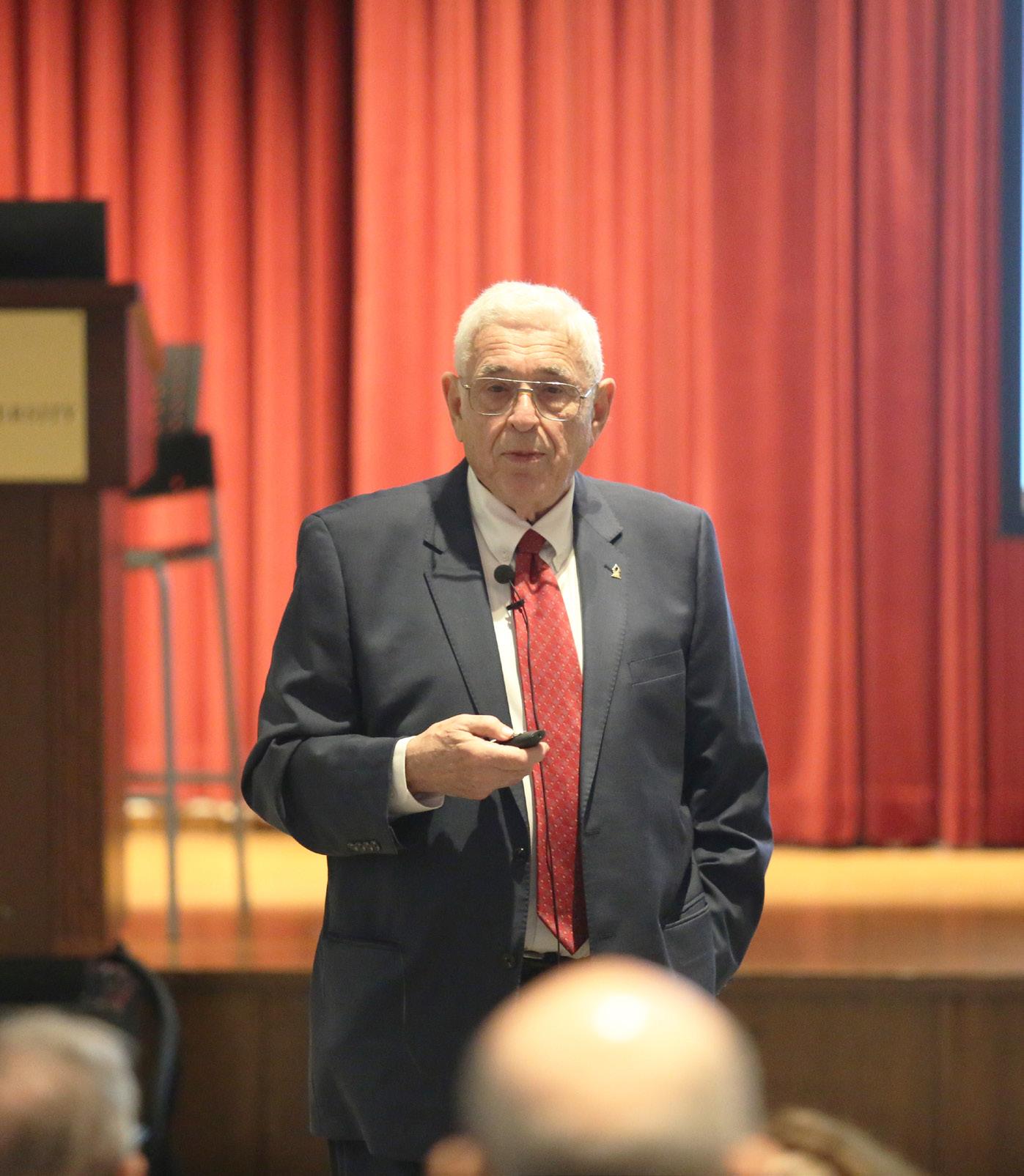
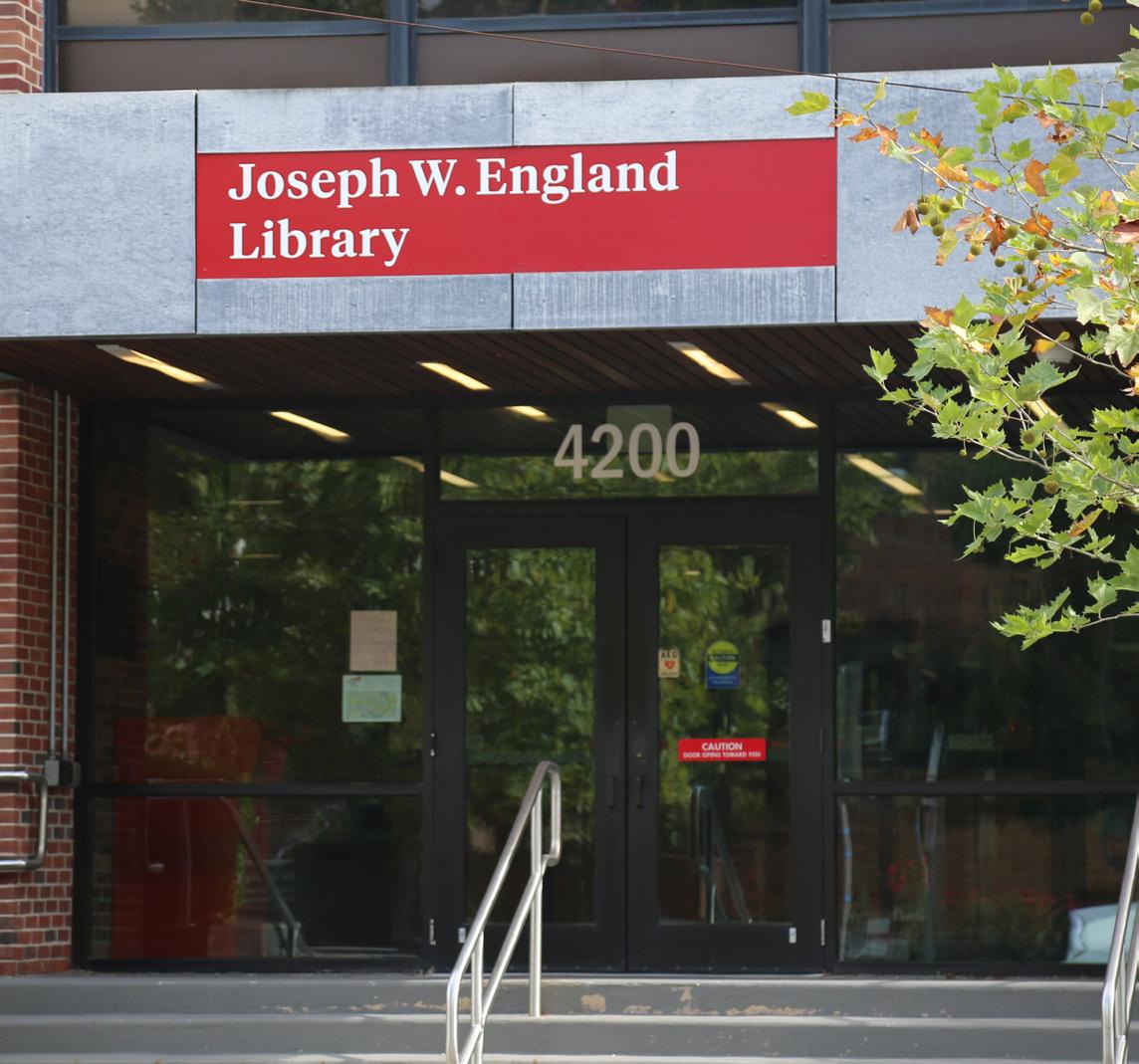
“ENGLAND
Both used the England Library as their home base, and now, both have relocated into rooms in the Athletic/ Recreation Center (ARC), just a year after moving into England Library from Alumni Hall.
“Ultimately, our goal is to find a space that allows us to be visible to students and accessible to students in the community,” said Jenny Spinner, Ph.D., professor of English, director of the Writing Center and faculty advisor for HawkHUB.
The Writing Center’s location in the ARC is smaller than their former England Library space, said Billy Scott ’25, DPT ’27, lead tutor on the UCity campus.
“Now we only have three tables, two chairs. Our reception desk is outside of the room, and there’s no back office for where our supervisor would normally be,” Scott said. “It’s definitely a lot more intimate of a space. I can imagine if there’s more than one appointment going on here, it could be a little hectic.”
Even so, Spinner said the staff of both the Writing Center and HawkHUB are trying to stay positive and send the message that “We’re still here.”
“You’ve got to go find us again,” Spinner said, “but we’re here for you. For HawkHUB in particular, we understand that there’s a need, there’s food insecurity at UCity as well, and as long as we have a campus there,
HawkHUB will be there.”
Kyla Valver ’25, DrOT ’27, a UCity library student worker, said she was “surprised in a good way” by the new space in Griffith Hall but still misses England Library.
“I feel everyone was like, ‘Oh my God, it’s in Griffith? What?’” Valver said. “It’s not terrible. I like how there’s a lot of windows and a lot of lighting compared to the [England] Library. But I do still miss the library, because that was one of our buildings.”
Liang Ren ’25, PharmD ’27, University Student Senate’s vice president of University City, said the closure of England Library is going to be a major adjustment for students across the UCity campus.
“For a lot of our students, it’s the loss of that space that really gets to them,” Ren said. “That melancholic feeling of, ‘Wow, my campus, the place that I used to call home, the place that I had many finals, had many countless nights, countless hours studying, is being gutted.’”
In situations like these, Wilson said, it is essential to keep moving forward.
“Each year, each day changes,” Wilson said. “Each day brings a new set of challenges, but not just challenges. It brings celebrations. It brings everything. If I’m stuck across the street because I don’t want to leave the England Library, I won’t get to come over here and see the beauty and the new opportunities.”
Department of Public Safety reports (Sept. 14-Sept. 20)
Sept. 14
Public Safety notified of a theft at the Hawks’ Landing Parking Garage. Philadelphia Police Detail notified, item recovered and a report was taken. Incident under investigation.
Public Safety notified of a liquor law violation at Villiger Residence Center. Incident was investigated. Community Standards was notified.
Sept. 15 No incidents to report.
Sept. 16
Public Safety notified of an attempted robbery at the Hawks’ Landing Parking Garage. Philadelphia Police Detail responded and a report was taken. Incident under investigation.
Sept. 17 No incidents to report.
Sept. 18 No incidents to report.
Sept. 19 No incidents to report.
Sept. 20
Public Safety notified of a trespassing incident at Barbelin/Lonergan Hall. Philadelphia Police Detail notified, responded and arrested the respondent.
S. Ilan Troen speaks to an audience in the Mandeville Teletorium about the multiple narratives surrounding Israel and Palestine, Sept. 16. PHOTO: MADELINE WILLIAMS ’26/THE HAWK
The exterior of Joseph W. England Library, Sept. 20. PHOTO: MADELINE WILLIAMS ’26/THE HAWK

Editorial: UCity library services remain integral to campus life
Amid the plethora of new and exciting updates to the Hawk Hill campus’ infrastructure, including the recent reopening of O’Pake Fitness & Recreation Center and the upcoming unveiling of Post Crossing Sept. 26, it is easy to overlook that St. Joe’s is experiencing unexpected challenges on other campuses.
librarians, maintenance staff and faculty worked to preserve pockets of space where students can physically gather, retaining study rooms and replicating the feel of the England Library in a new setting.
The closure of England Library further compounds what has already been an emotional experience for the UCity population following the closures of Goodman Hall, Osol Hall, Wilson Dining Hall and other spaces on the UCity campus. Amid these changes, we commend the library staff, who have gone to extraordinary lengths to provide some semblance of normalcy for the UCity students who deserve to have spaces available throughout their college careers. Editor-in-Chief
The early closure of the University City campus’ Joseph W. England Library due to an HVAC system failure, as reported in this week’s issue of The Hawk, has greatly accelerated the library’s move to Griffith Hall. Over a matter of weeks,
Study rooms, community spaces and social environments are an unquantifiable aspect of college. Libraries — which contain all three — are especially significant in forming the college experience. It’s what makes college the launching point for lifelong social, academic and professional success, rather than just a four-year layover ahead of one’s career.

September: Recovery month

Happy National Recovery Month! During September, we honor the approximately 20.9 million Americans who have struggled with substance use and found recovery. We also celebrate programs that support people in recovery, such as St. Joe’s own Collegiate Recovery Program. Collegiate Recovery Programs are important because they provide specialized services and support to students in recovery and educate others on substance use disorder (SUD). Recovery, as defined by the Substance Abuse and Mental Health Services Administration, is “a process of change through which individuals improve their health and wellness, live a self-directed life, and strive to reach their full potential.” This inclusive definition can be applied to SUD, a mental health concern, an eating disorder or other process addictions.
You may notice the definition does not specifically identify abstinence from substances as a requirement for recovery. While many people in recovery choose not to use substances in any form, others take a harm reduction approach, which involves decreasing their substance use or taking measures to use substances in a safer, less harmful way.
While there are many forms of treatment for people with SUD, the stigma associated with it and other mental health concerns often prevents them from seeking support. Throughout history, substance use and mental health concerns were regarded as personal failures or the result of bad choices. While we now know these concerns develop as a result of biological, social and environmental factors, the judgment surrounding them still exists.
If you have a loved one who is struggling with substance use, please remember their struggle is not a choice. It is the culmination of many factors in their life, which could include traumatic experiences as well as

feeling isolated from others. I encourage you to show them empathy and patience. You may also want to seek guidance and support for yourself on this journey. Groups like Al-Anon exist specifically for family and friends of people struggling with SUD. Or, you can seek out resources on campus like Counseling and Psychological Services (CAPS) or the Collegiate Recovery Program’s Allies of Recovery training.
Aimee Della Porta, LCSW, is a psychotherapist at CAPS and works in the Collegiate Recovery Program.
Members of the St. Joe’s community seeking support are encouraged to contact the following resources:
Counseling and Psychological Services (CAPS), 610-660-1090
Campus Ministry, 610-660-1030
The Office of Student Outreach & Support, 610-660-1149
The Jesuit community, 610-660-1400 Employee Assistance Program, 866-799-2728
A call to ecological conversion at St. Joe’s
CLINT SPRINGER Guest Columnist

During the summer, University President Cheryl A. McConnell, Ph.D., announced St. Joe’s commitment to the President’s Laudato Si’ Initiative on Sustainability and Stewardship. This initiative is a transformative step forward, rooted in St. Joe’s Catholic and Jesuit identities to promote justice, service and care for creation. This bold commitment challenges every member of the St. Joe’s community — students, faculty, staff and alumni — to take an active role in fostering an ecological conversion on our campus. Inspired by Pope Francis’ call in “Laudato Si’” to care for our common home, the Earth, this initiative goes beyond simply implementing sustainable practices. It’s about reimagining how we interact with the environment, each other and the broader world. As a university, we have the opportunity and responsibility to lead by
example, creating a culture of sustainability that influences both our campus and the wider community.
Each of us has a role to play in carrying this vision forward. For students, it’s about engaging in coursework and projects that challenge them to think critically about environmental issues and their social implications. Faculty can infuse their teaching and research with themes of sustainability, while staff can support policies and practices that make our campus operations greener and more efficient. Alumni and partners can contribute by sharing their expertise, resources and support for initiatives that drive meaningful change.
But true ecological conversion is more than a series of actions; it requires a shift in mindset. It calls us to reflect on our personal choices, our community norms and the systems we support. This transformation will not happen overnight, but with collective dedication, we can cultivate a more sustainable and just campus environment.
St. Joe’s has always been committed to
forming individuals who are with and for others. Now, we extend this commitment to the Earth itself, recognizing that caring for creation is integral to our mission. Together, as Hawks, we can make a significant impact — one that echoes far beyond our campus, inspiring others to join us in building a more just and sustainable world.
Clint J. Springer, Ph.D., is an associate professor of biology and the director of the Institute for Environmental Stewardship and the Barnes Arboretum.
AIMEE DELLA PORTA Guest Columnist



Conservative visa reforms restrict freedom
CAROLINE TRIMBLE ’26
Hawk Columnist


The authors of Project 2025 argue that the Department of Homeland Security (DHS) is in desperate need of reform.
The document says the DHS is a “bloated, bureaucratic, and expensive” organization that has failed to meet conservative standards for immigration regulation and has allegedly “suffered from the Left’s wokeness and weaponization against Americans.”
Project 2025 calls for several troubling immigration reforms,
including the elimination and limitations of certain visas. Something particularly disturbing is Project 2025’s claim that “victimization should not be a basis for an immigration benefit.” In 2000, Congress passed the Victims of Trafficking and Violence Protection Act, which offered legal status to undocumented victims of abuse. The authors of Project 2025 argue that the T and U visas created by this act are unnecessary and should be eliminated. They reason that victims of trafficking and similar crimes are “actively and significantly cooperating” with the police and serving as witnesses against their abusers, and, therefore, will already qualify for an S visa. S visas are
Beyond the commute
granted to any immigrant who provides “critical, reliable information” about criminal activity, whereas T and U visas are specific to victims of abuse.
There are several problems with this proposed change. For starters, S visas are capped by Congress at 200 granted per fiscal year, significantly limiting the number of trafficking victims who would be eligible for legal status. It is also unclear what exactly counts as “critical, reliable information,” making the acceptance for an S visa extremely subjective compared to that of T and U visas.
Project 2025 also urges the next conservative president to “prioritize national security” in the Student and
Exchange Visitor Program. The authors argue U.S. Immigration and Customs Enforcement must take control back from educational institutions to reduce the number of visas given to students from “enemy nations,” which are not defined in the document.
These reforms would unfairly reject international students based solely on their nationality, and the proposed visa reforms immorally strip away legal protections from human trafficking victims. These policies undermine the United States’ most basic and founding values of freedom and justice “for all.”
Navigating college life as a commuter at St. Joe’s
KESIAH VAUGHAN ’25 Guest Columnist

As a recent transfer student from Cabrini University and the commuter executive president of Hawks in Flight, a student group for St. Joe’s commuters, I know balancing the demands of college life while commuting can be a challenging experience. It can also be rewarding with the right mindset, so here are some strategies to help commuter students juggle their multiple responsibilities and thrive at St. Joe’s.
Firstly, it’s crucial for commuter students to create a structured schedule. This involves planning study times, work
hours and social activities in advance. This way, students are able to take advantage of on-campus events while still having enough time for other aspects of their life, reducing stress and improving productivity.
Secondly, commuter students should make an effort to get involved on campus, as they cannot rely on residence halls or other built-in communities as much as students who live on campus. Joining clubs, organizations or sports teams can provide a sense of belonging and community, which are essential for personal and professional growth. These activities also offer opportunities to network with peers and faculty, which can be difficult for commuters who may not spend a lot of time on campus outside of classes.
Thirdly, commuter students must
prioritize their mental and physical health. With the added stressors of commuting, such as scheduling around travel times, finding parking and participating in extracurriculars, it’s important to find time for relaxation and self-care. Whether it’s hitting the gym, meditating or simply taking a walk, finding an outlet to decompress is vital for maintaining this balance.
Lastly, building a strong support network is key. This includes forming study groups, reaching out to professors and connecting with other commuter students. Sharing experiences and tips with other commuters can provide valuable insights and foster a sense of camaraderie.
While commuting to St. Joe’s may present unique challenges, with proper planning and resource utilization, commuter
‘Canvas’-ing for the election
GRACE HELLER ’26
Guest Columnist
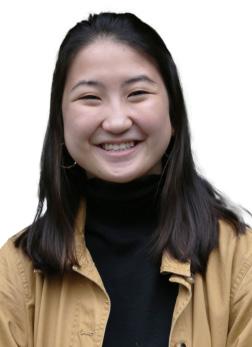
St. Joe’s mission statement promotes a “lifelong commitment … to pursuing social justice.” To honor this objective, St. Joe’s curriculum has supported numerous courses, such as Economics of Poverty & Income Distribution, Religion & Race in Philadelphia and Inequality in American Society. Moreover, it is no secret St. Joe’s encourages civic engagement of all forms with an active SJU College Republicans club and a newly-relaunched SJU College Democrats club. The university is also home to advocacy and philanthropic groups, including SJU for Refugees & Migrants, HawkHUB and Hawks for Just Employment.
Nearly everything about our campus culture would suggest election day participation would rank high among the university’s priorities. However, even with
groups on campus canvassing student voters, St. Joe’s has erroneously decided logging on to Canvas is more important. The university should reconsider giving the day off to vote, especially since the nation lacks voter engagement from college students and young adults.
According to the U.S. Census Bureau, voter turnout in presidential elections for people ages 18 to 24 years old has stayed below the national average since 1964. The outlier was 2020, in which voter turnout in college students was comparable with the rest of the public, according to a 2021 Tufts Now article.
Despite this evidence showing a surge in college voter participation, St. Joe’s leaves its student body on its own to squeeze in a drive home between classes or find time to apply for, receive and send in a mail-in ballot. Some people may think an entire day off for voting is unnecessary, but the risk of a mail-in ballot being rejected or not being delivered to one’s residence or
the county election office remains a valid concern. In 2020, Pennsylvania rejected approximately 21,800 mail-in ballots and multiple municipalities felt forced to erect drop boxes in an attempt to receive votes before the deadline.
students can achieve a fulfilling college experience. By prioritizing their well-being, engaging with campus life and leveraging available support, commuter students can successfully balance their responsibilities and make the most of their time at St. Joe’s.

St. Joe’s students will have to count on election officials to fine-tune these processes, since many will be stuck on Canvas. However, it’s not too late for the university, or professors, to announce an asynchronous day, if not cancel class.

GRAPHIC: CARA HALLIGAN ’25/THE HAWK
GRAPHIC: STEPHANIE SAVELA 25/THE HAWK
GRAPHIC: STEPHANIE SAVELA ’25/THE HAWK

South Africa Stories

‘There is a future for girls’ rugby’ Capping ceremony tackles inequality
Number 8 for the girls’ U16 team.
Durban, South Africa Forty-six athletes took a step towards a better future for women’s rugby June 23 at the Hollywoodbets Kings Park Stadium, hometotheDurbanSharks,aprofessional rugby union team.
Inside the media room at the stadium, which seats 52,000 fans, the players participated in the Sharks’ firstofficial capping ceremony for girls on the Sharks’ under 16 (U16) and under 18 (U18) provincialteams.
“We just want to be recognized for our talents,” said Akhiwe Msomi, who plays flyhalf for Mowat Park High School. “Because, in sports, it is not exactly equal. Girls’ sports are not really taken serious”
In rugby, the honorific term “cap” or “capping ceremony” refers to the number of times a player has been selected torepresentaspecificteam.
“Thecapisshowingthattheyrecognize thevalueofwhatthey’redoing,”saidXolandi Mthiyane, one of the parents in attendance. “It’s very important to recognize them and salutethem.”
During the ceremony, the Sharks capped 23 athletes from various schools across the KwaZulu-Natal province to make up the U16 and U18 teams. They competed in the South Africa Rugby Girls’ Week tournament, a provincial rugby tournament held July 1-4 consisting of teams representing the nine provinces or regionsthatmakeupSouthAfrica.
“It means a lot to me because I’m representing my team back home,” said Ndoniyethu Ngcobo, who attends Dabeka Secondary School and plays Lock and
In the world of South African rugby, women are often late to the sport, with fewer opportunities than men to play and sharpen their skills. The perception is that rugby is too rough for them.
“A lot of people told me it’s impossible, or that rugby is a male-dominated sport,” Msomi said.
Wandile Khumalo, a trans man who coaches the girls’ U16 team, has been rejecting that idea since he played for the South African national team.
“I’m a huge believer in equality,” Khumalo said. “Ideally, whatever happens for the boys can happen for the girls. That [capping ceremony] ticked one more thing off the list.”
Present during the ceremony were four South African women rugby stars who embody the athletes’ future visions of themselves: Mary Zulu, a fullback for the South African Women’s national rugby team; Setty Dlamini, a member of the Sharks women’s squad and the women’s junior Springboks; and Nomonde Mbanjwa and Phatheka Dzanibe, who both play flanker for the Sharks women’s squad. Each of the athletes gave a small speech at the ceremony, encouraging the young athletes to dream big.
“I’m here today because I want to see you guys pay it forward,” Dzanibe told the girls. “I’m here to pay it forward to you guys for you to pay it forward to the next generation that are coming behind you.”
All of the professional players emphasized the magnitude of this opportunity to compete on the provincial level.
“Women’s rugby is on the rise,” Dzanibe told the girls. “It’s growing. You
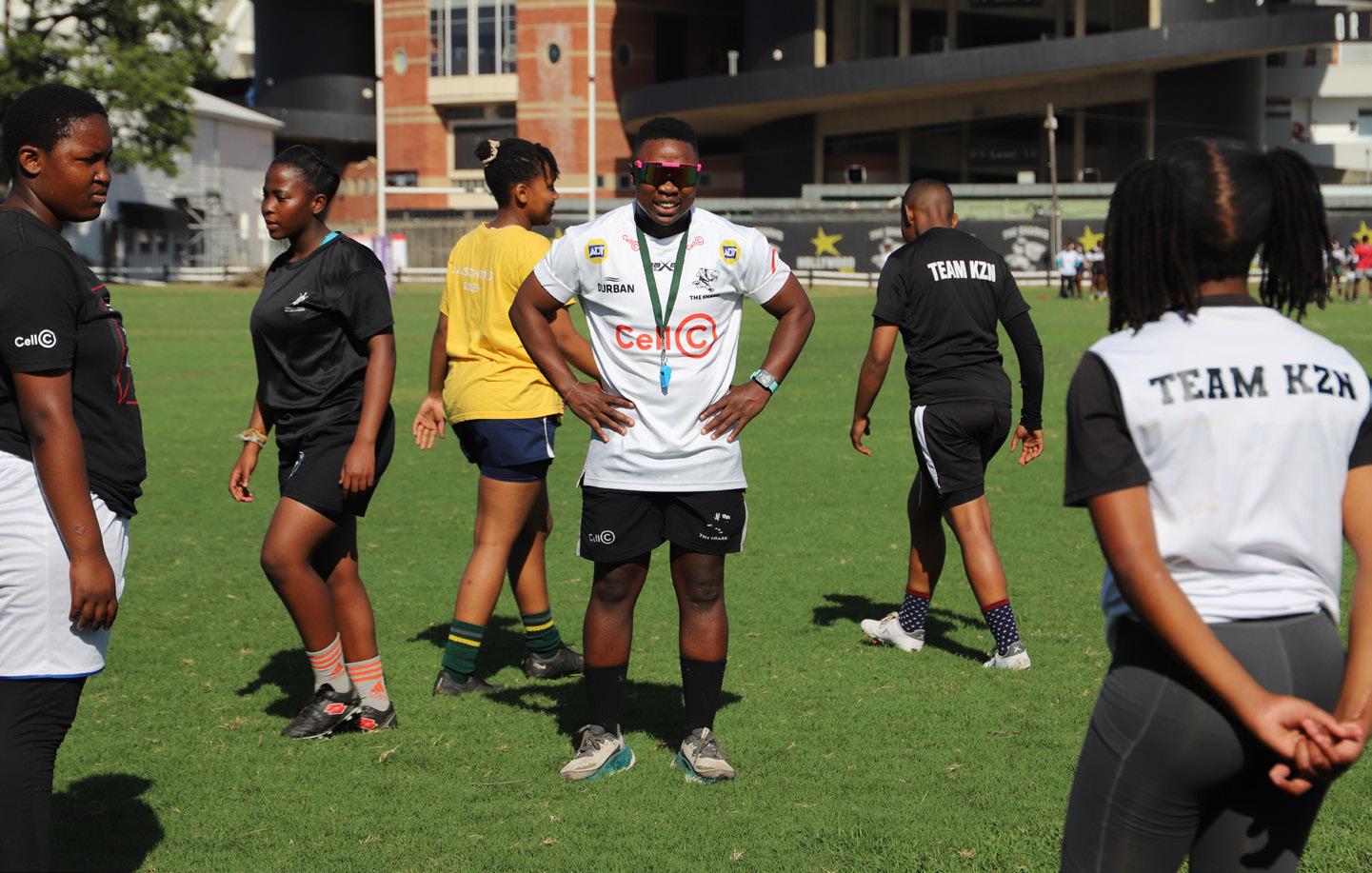
guys have been given that opportunity. You guys need to take that opportunity and use it wisely. It’s not a mistake that you guys are here. It could have been anyone. There are 100 girls that could have been here, but the coaches chose you. When you’ve been given that chance, take it and use it.”
For Risima Koza, a student at Mowat Park High School who plays prop for the U18 girls and is a former member of the U16 team, the message was well received.
“I saw how the women who came before me had to struggle so much so that we could be here and for us to have women’s rugby,” Koza said. “It motivated me so much. It gave me a drive to push because I know that there are women who went through so much. I also have to play my part in making the place where women’s rugby goes to. I also have to pave the way for other players coming after me.”
After the ceremony, the newly capped team members attended practice where they had time to work on both skills and teamchemistry.
Khumalo,whorantheU16practiceafter theceremonyinafieldinfrontofthelooming Sharks stadium, said he wants his players to understand the importance of leaning on others to achieve greatness, including on the currentstarsoftoday’sgame.
“Nothing great was ever achieved singularly,” Khumalo said. “It’s always with the people. You can never achieve anythinggreatonyourown.”
Msomi and the other girls seemed to understand that as they hugged and shook handswiththeiridols.
“There is a future for girls’ rugby,” Msomi said. “Some of us who are capped here today show that anyone could do it with the right amount of pressure you put onto yourselfattrainingandyourcommitment”
MAXIMUS FISHER ’25 Sports Reporter
Donning their Durban Sharks kits for the first time following their capping ceremony, the U16 Sharks players hone their skills during a training session.
PHOTO: ZACH PODOLNICK ’26/THE HAWK
Coach Wandile Khumalo preps the Durban Sharks’ U16 girls rugby team for their first game of the South Africa Rugby Girl’s Week Tournament against Griquas. The Sharks would go on to win the July 2 game 10-0.
PHOTO: THE HAWK


Fit to be king Wakanda Food entrepreneur teaches others to dream big
LILLI DELLHEIM, M.A. ’25
Special to the Hawk
Johannesburg, South Africa Miles Kubheka, a food entrepreneur and systems-change enthusiast, has a history of finding inspiration and solutions hidden in plain sight.
“I think I knew I wanted to be an entrepreneur from early on. My mom always said to me, ‘Go out and change the world. Stand for something. Be somebody.’ And I remember thinking to myself, ‘Lay off me, woman. I’m only three years old,’” said Kubheka with a laugh.
Years later, Kubheka now empowers food entrepreneurs and chefs with opportunities to grow through a business he founded in 2020, Wakanda Food Accelerator. The accelerator helps innovative seed and startup businesses in the food, agriculture and beverage industries to grow and access new markets. It has supported over 400 businesses to date.
The accelerator’s name is a nod to the fictional African utopia in Marvel’s “Black Panther,” a movie Kubheka loves.
“It portrays Africa in such a positive light,” Kubheka said. “I’d never seen that at a global scale, so I left [the movie] so inspired.”
One of the entrepreneurs Wakanda Food Accelerator has helped is Chantelle de Bruyn, who created an innovative caffeine-free coffee made from vegetables through her agribusiness startup, Buttercup Farmhouse. De Bruyn came up with the idea after her grandfather was diagnosed with a liver and kidney infection and was told he could no longer drink his beloved coffee.
“Our participation in this accelerator has not only boosted our growth, but also we try to reinforce our commitment to delivering high quality and unique
products to our customers,” de Bruyn said.
Kubheka’s favorite aspect of the business are Wakanda Food’s ghost kitchens, bright yellow shipping containers in the Sandton and Melville neighborhoods of Johannesburg that are outfitted with all of the necessary restaurant gear, from deep fryers to large grills to mixing bowls.
“All they need to do is bring their knives,” Kubheka said.
Wakanda Food Accelerator sets up entrepreneurs who use the kitchens with a point-of-sale system and seminars on business, including basic business skills
like marketing, sales and operations, and advice on sourcing ingredients. While ghost kitchens typically are set up for delivery or pick-up orders only, Wakanda Food’s container kitchens also serve walk-up customers.
Couple-turned-business-partners Khumo Ya Baselsana Maromula and Thando Tshepuwane have been part of Wakanda Food Accelerator for almost a year, operating Base Eats from a ghost kitchen in Sandton. The two met in culinary school and first started selling their variation on braai (barbeque) cuisine
and achar (pickled vegetables) out of their family home in Pretoria, 36 miles north of Johannesburg.
Maromula applied to a handful of programs for food entrepreneurs. When she got the call from Wakanda Food, she knew it would change the trajectory of their lives. Relocating to Johannesburg, the couple said their involvement with Wakanda Food helped them with the business side of their food startup.
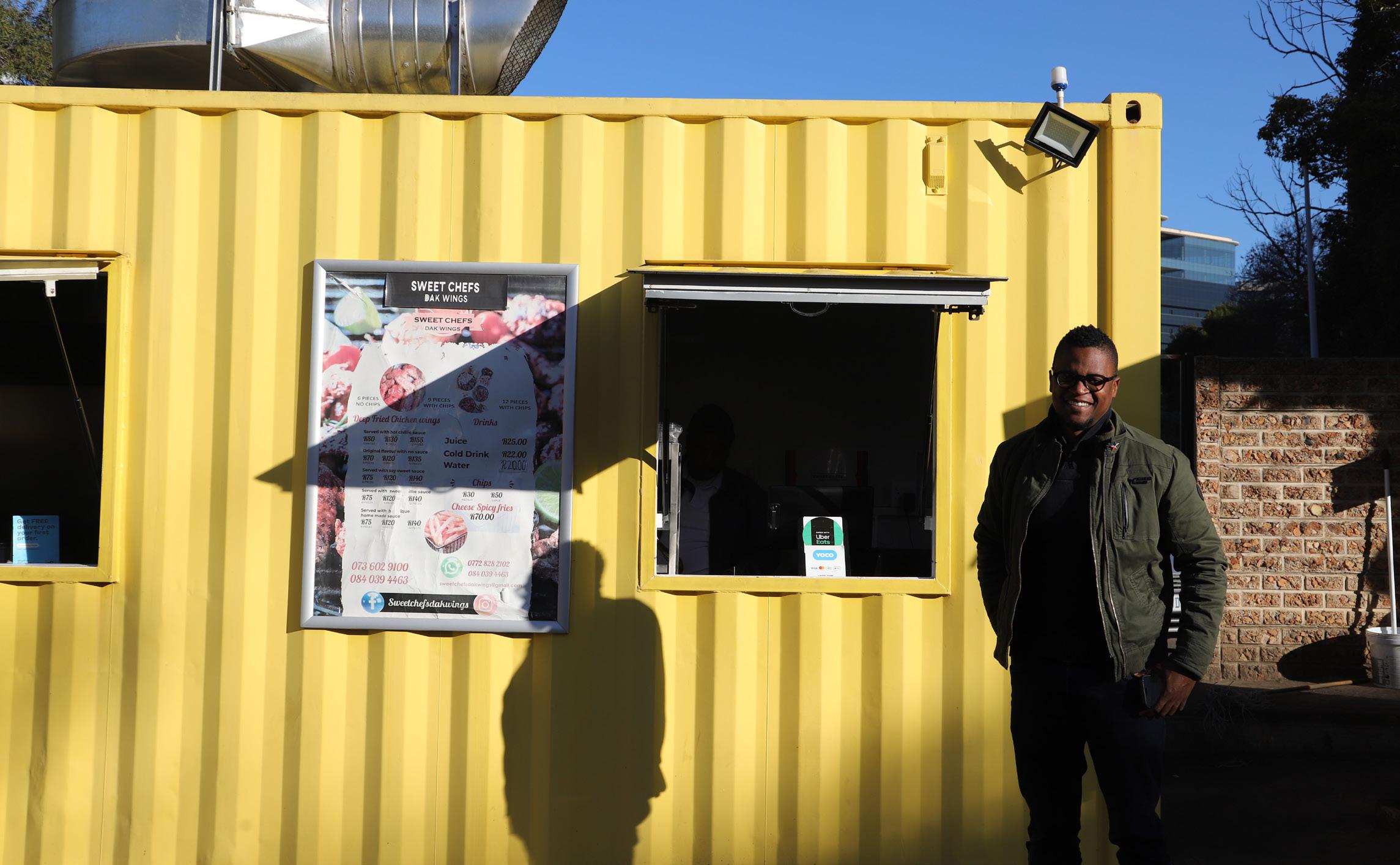
A customer visits one of two refillery stores Wakanda Food Accelerator set up in shipping containers in the township of Alex as part of a project called Gcwalisa.
PHOTO COURTESY OF WAKANDA FOOD ACCELERATOR
Miles Kubheka, next to one of the ghost kitchens Wakanda Food Accelerator helps to support, says he knew from a young age his mission was to change the world. PHOTO: LILLI DELLHEIM, M.A. ’25
“WAKANDAFOOD“CONTINUED ONPG.7

“Learning how to do your own bookkeeping, that’s been really, really helpful,” Maromula said. “We had to catch up from 2016 all the way till 2023 last year in August.”
For Base Eats, the next stage is all about growing nationally.
“Initially, our goal is to actually have a fleet of food trucks based all around the country,” Tshepuwane said. “We want to be at that point where, if there’s an event in Joburg, there’s an event in Cape Town, there’s an event in Durban, I am there.”
Kubheka focuses on entrepreneurs from the city’s townships, including nearby Alexandra, or Alex, as it’s locally known, and Soweto. Many Alex residents struggle with high levels of unemployment, crime, population density and inadequate infrastructure, including, in some parts, basic necessities like water and plumbing.
Townships like Alex were created by the apartheid government under the Group Areas Act of 1950 when Black, Indian and coloured — a non-derogatory term in South Africa that means mixed race — South Africans were forcibly removed from areas subsequently reserved for white South Africans. For Kubheka, the “apartheid design” of townships further creates obstacles for entrepreneurs.
“They were designed as dormitories,” Kubheka said. “There’s no high rises in townships. There’s no offices. People who do have work and jobs leave in the morning, at six o’clock, to go to the [Central Business District]. So, if you’re running a township business, there’s no one. The people who are left there are not employed.”
Kubheka was intentional about his decision to set up the container restaurants
in Sandton, one of the wealthiest areas in Africa and Johannesburg’s bustling finance center.
“I take the entrepreneurs that I think have potential and put them in the richest square mile in Africa and see if my hypothesis is right, that they will do better here than spending a lot of money trying to make them sustainable in the township,” Kubheka said.
Kubheka pointed to one township business he helped, which he said went from making R16,000 ($889) a month in Soweto to R170,000 a month ($9,445) in Sandton.
“Would you rather have a sustainable business that sends money to the township or a township business that’s not making money in the township?” Kubheka asked.
Sweetness Simata, who lives in Alex, started working with Wakanda Food Accelerator doing a learnership (internship) right out of culinary school. Once his learnership ended, his entrepreneurial journey began.
“I told myself that I’m gonna create my own employment because everybody’s complaining about job opportunities, but I went to a culinary school, so I can’t be complaining if I have my own skills that I can use to start my own business,” Simata said.
In July 2022, Simata opened a container kitchen in Sandton called Sweet Chef’s Dak Wings, a variation on fried Korean wings with an African twist. Simata blends traditional South African recipes for chakalaka or achar to create a sauce he pours over his signature glazed wings.
Sweet Chef’s Dak Wings will be a good test of Kubheka’s hypothesis about the viability of a business in Sandton versus Alex. Simata just launched a second location in Alex and has dreams of expanding to local events like music

festivals and weddings. He said Wakanda Food taught him the business and leadership skills he needs to expand operations.
“I’ve learned how to manage it and how to manage other people,” Simata said.
In Alex, Kubheka started a new project called Gcwalisa. A Zulu word that means “fill up,” Gcwalisa operates two refillery stores from shipping containers where patrons pay what they can to stock up on bulk supplies of items like laundry detergent, maize meal, sugar and dish soap.
Similar to the U.S., refillery stores often focus on zero-waste, with patrons bringing their own containers to fill. Gcwalisa shares this ecological approach, but it also has a social component. In townships like Alex, where limited cash flow is an everyday reality, the weigh-and-pay model enables residents to buy only what’s needed for the day, which can make a big difference in terms of basic needs and
personal dignity. Solar panels on top of the refillery also help supply needed power to neighboring homes.
Kubheka said he hopes to have up to 10 of the refillery stations operational by the end of the year.
For Kubheka, the next great challenge is scale. Inspired by the grassroots work he does in Johannesburg, he now dreams about pan-African solutions.
“For me, it is to … see how I can make my continent a better one,” Kubheka said.
Just like the Black Panther protagonist in the movie he loves, Kubheka said he’s had a sense of his purpose from a young age.
Kubheka’s message to other entrepreneurs has a bit of a superhero edge as well: “You can design your life the way you want it to be,” he said.
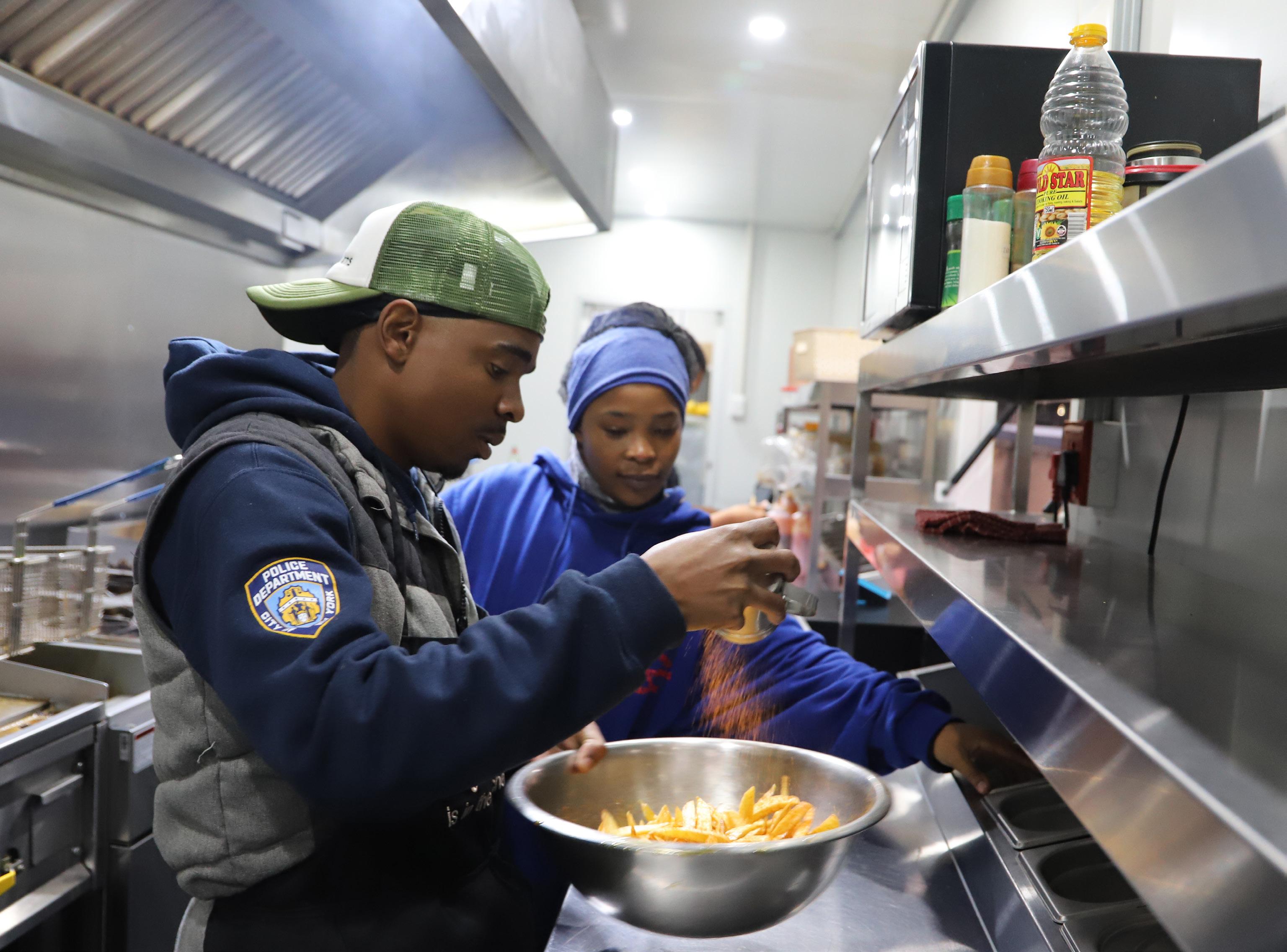
Thando Tshepuwane (left) and Khumo Ya Baselsana Maromula (right) prepare food in their Sandton ghost kitchen for their business, Base Eats. The couple credits Wakanda Food Accelerator for putting them on the path to success. PHOTOS: LILLI DELLHEIM, M.A. ’25
Customers are able to purchase whatever amount of a variety of bulk items they are able to afford at one of the refillery stores Wakanda Food Accelerator operates.

‘Down below’ museum preserves southern African art
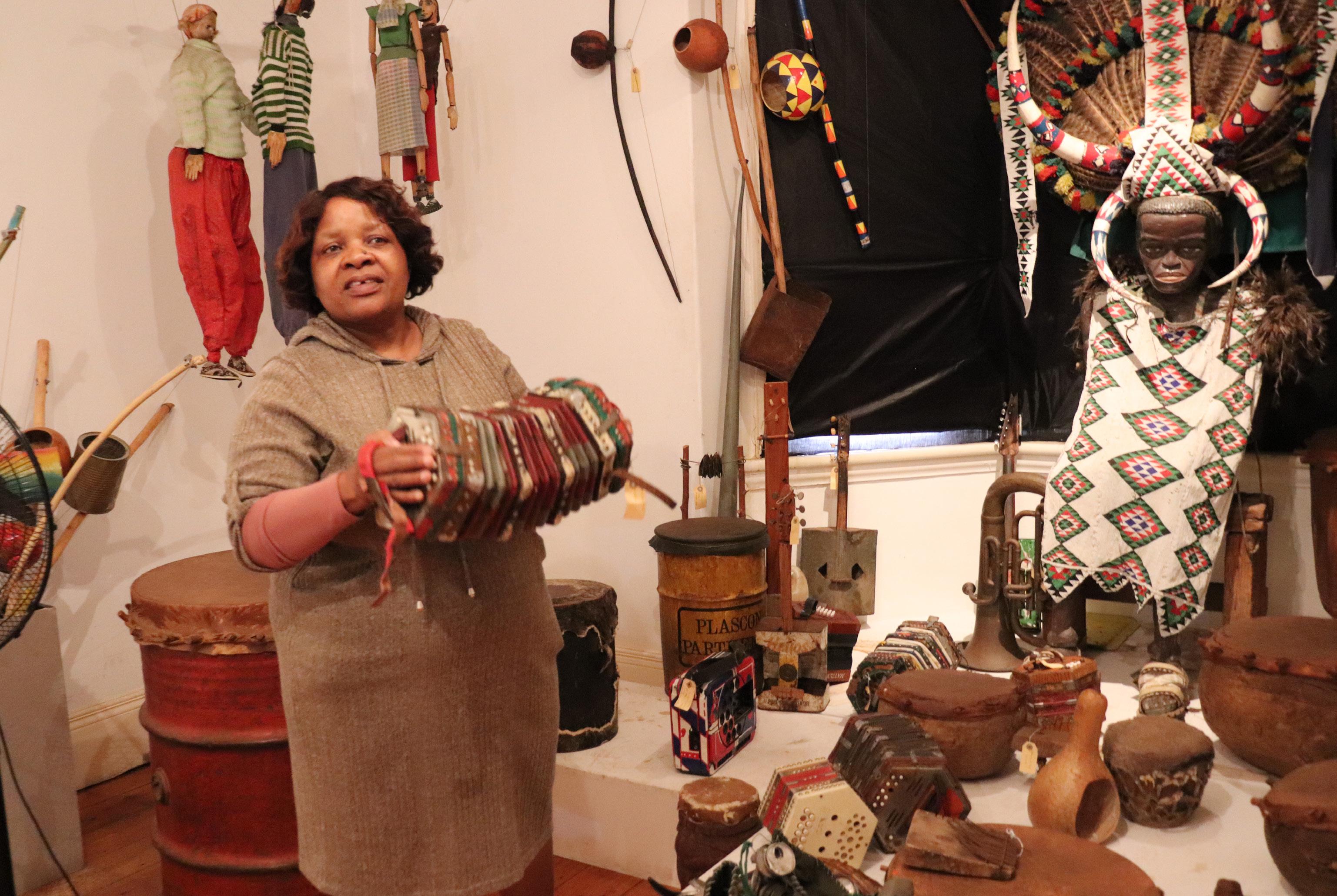
Durban, South Africa — Phumzile Nkosi often breaks into song when she takes visitors on a tour of the Phansi Museum. Or she will demonstrate Zulu ceremonial dances related to some of the artifacts and objects in the museums collection of southern African art
Nkosi, the museum’s curator and manager, said the museum has had a profoundimpactonher,andnotjustbecause she has cleaned artifacts and cataloged metadataforalltheworksinthemuseum.
“Phansi restored the love of my culture,” Nkosi said, “because since I’ve been here, I’m feeling very proud to share the story behind our African collection”
That story began humbly for Nkosi. In 1996, architect Paul Mikula, an avid collector of art, hired Nkosi to serve tea and do custodial work for the architecture practice he shared with several partners. Fouryearslater,MikulaandNkosiworked in collaboration to open the museum
“We both are a unit,” Mikula said. “It’s still going now, years later”
In her new role, Nkosi took on management andcuratorialresponsibilities.
“My contribution was my indigenous knowledge when it comes to the artifacts,” said Nkosi, who herself is a talented beadworker, a functional art form popular in Zulu culture.
The Phansi Museum, located in the Glenwood suburb of Durban, occupies three floors of the Esther Roberts House, a restored colonial era house named after Esther Roberts, one of the first woman cultural anthropologists in Durban in the early 20th century. The museum’s collection contains approximately 9,000 African artifacts from across southern Africa, and is spread over five gallery spaces in the house, from the basement to the first and second floors. Among the artifacts are life-size marionettes wearing traditional dress, woven baskets, pottery, fertility dolls, art from the Xhosa, Zulu andNdebelecommunities,andbeadwork.
Mikula and Nkosi said the museum’s name has more than one meaning. Phansi means “down” or “below” in isiZulu, referring to the basement, which houses items from the museum’s very first collections.
“But, it’s also the other Phansi, the forefathers. So this [idea] actually came from the forefathers. And you’ll know that if you don’t respect the forefathers, you can hit your head against it,” Mikula said jokingly, referring to the low entranceway leading to the basement.
Many of the items in the museum’s collection date back to the 1970s when Mikula developed a fascination with art and began collecting art from southern Africa.
“I love art,” Mikula said. “I’m an architect, but it’s the art, that thing that I think is the most beautiful thing.”
Many artifacts collected by Mikula and the museum staff were donated or acquired through connections Mikula makes with the people he encounters.
“You go out and you find people in the various areas who are guides,” Mikula said. “And so you start to get to know them.”
The Phansi Museum places a strong emphasis on the pre-colonial culture of South Africa and the artifacts created in the rural areas of the country, where some of these types of art are still made.
The museum has a collection of Zulu grass mats, or “Amacansi,” which Nkosi said are intricately woven mats that could be used for many different functions.
“[The Amacansi] are very special to us because we use them for seating,” Nkosi said. “We used them for sleeping before mattresses and to bury their loved ones. So we were using grass mats to wrap them and bury them in peace. Grass is very important to us.”
The museum also contains a variety of instruments, including drums and shakers filled with beads or seeds. When taking guests through the exhibit one day in late June, Nkosi played an accordion and explained the importance of singing and dancing in Zulu cultural traditions.
“When it comes to singing and
dancing, talk to us. We are very good at composing our own songs,” said Nkosi, explaining that songs allowed people to relay family problems they weren’t supposed to tell others directly about. Maybe they were low on food or their husband had gone off.
“I will wait, I will wait till he comes back,” Nkosi sang, moving in a circle and lifting one knee toward her chest.
Other artifacts in the museum include intricately beaded wire and clay pots, hand-carved fertility dolls and a wooden funeral boat from northern Mozambique crafted in the shape of a fish. Nkosi removed the fish’s head to show visitors cow skin lining the inside. While the boat is usually sealed once the body of the deceased is placed inside, this particular boat was never used.
Mikula said now that he is 84 years
old and ill, he has to think of a succession plan for the Phansi Museum.
“We are trying to find somebody to take it over,” Mikula said. “I’ve got cancer and all that sort of stuff, so I won’t be around too much longer.”
Mikula said he is hopeful a nearby university will take over the museum, and discussions are taking place for that to happen.
“We are actually very excited about that because it means they’re going to start another campus here, and so their students can work with this stuff,” Mikula said.
Nkosi said whatever happens, she would like to keep guiding visitors through the museum and telling them the stories behind the artifacts.
“I really enjoy taking people around in the museum,” Nkosi said, “and my hope is to see the museum growing, flourishing and doing more than this.”
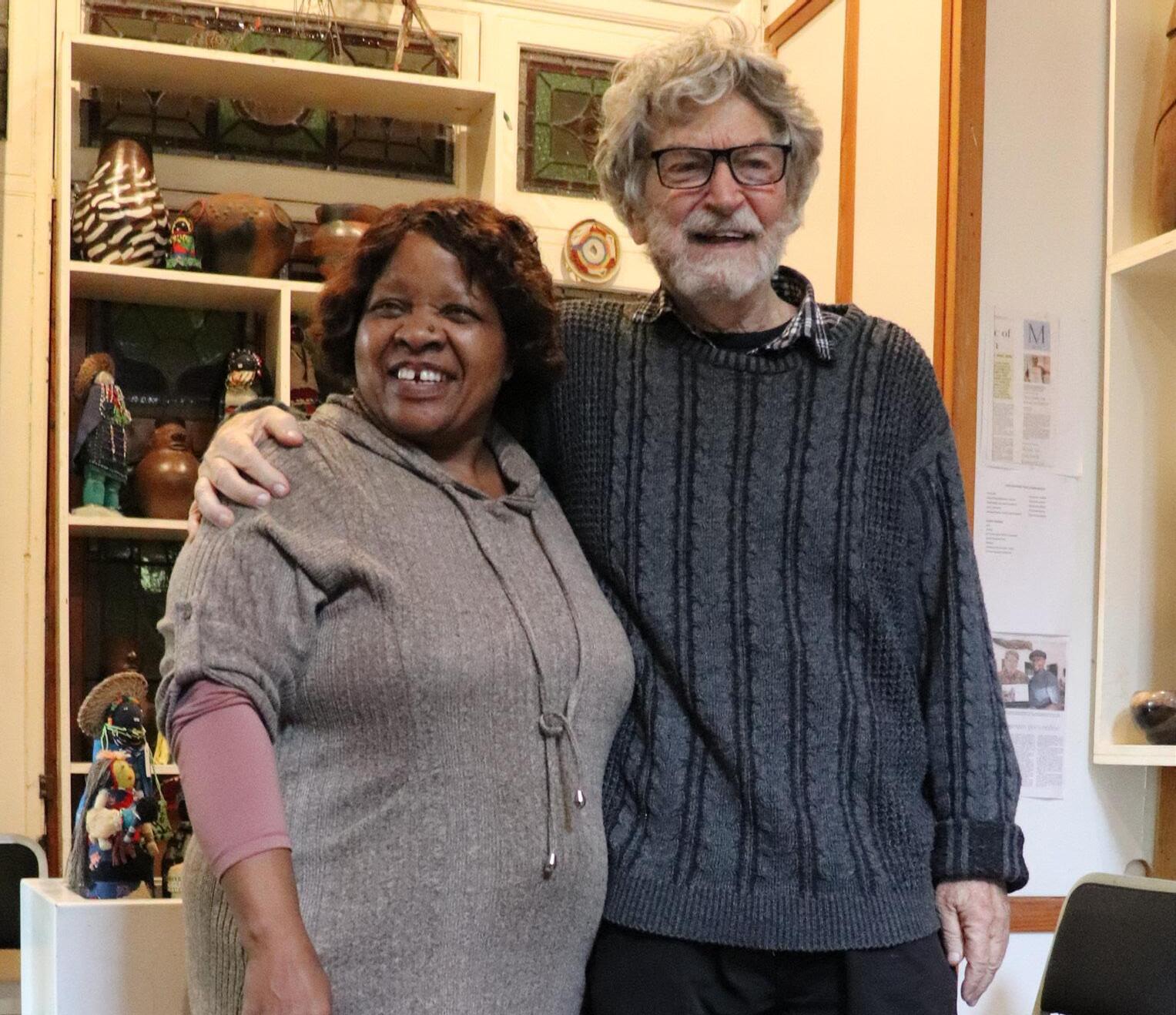
RYAN DAILEY ’25
Special to the Hawk
Phumzile Nkosi, Phansi Museum curator and manager (left), and Paul Mikula, museum founder and avid art collector (right), have known each other since 1996. PHOTOS: LILLI DELLHEIM, M.A. ’25
Phumzile Nkosi, curator and manager of the Phansi Museum, plays an accordion, one of many musical instruments in the museum’s collection.
All-natural simplicity drives student entrepreneur’s cosmetics business
HANNAH PAJTIS ’26
Features Editor
In 2020, during the covid-19 lockdown, Bianca Brown ’27 started making skin care products with her mom from her house, experimenting with ingredients in hopes of creating a product that helped her eczema. Four years later, Brown is the CEO of her all-natural skin care business, SimplyB, and has received over 1,000 orders for her homemade body butters, body scrubs and lip glosses.
“My mom was like, ‘Well, you could definitely start a business doing this,’” Brown said. “So I started selling small things to my local community, and then I got a few orders for the first time locally. I eventually created a website and then they took off from there.”
Shortly after launching her business, Brown went viral on TikTok and received a mass influx of orders. At first, Brown described the situation as “stressful,” because all of her products were made-to-order. Brown, who was doing hybrid in-person and at-home learning because of covid-19, balanced making products from home and going to school.
When Brown was featured on Philadelphia’s 6abc news the following year, she was better prepared for increases in orders.
“I was more prepared because after the whole TikTok thing, I knew how to make my products in bulk,” Brown said. “That was a lesson that was definitely to be learned, and that was really cool because that helped me get a lot of the return clientele I have today.”
SimplyB products come in a variety of scents and themes. Some, like her Birthday Cake Foaming Body Scrub, are dessert-inspired. Others, like Lily Blossom Body Butter, one of Brown’s personal favorite products, are inspired by florals.
Brown said it’s important for her body butters and scrubs to be all-natural, unlike the skin care products she used before founding SimplyB, which had harmful chemicals. Ingredients in her body butters, which she sources from third-party distributors, consist of products like shea butter, cocoa butter,
almond oil and hemp seed oil. Her recipes have changed throughout the years and have been refined over time.
“Some of it is a little bit of trial and error,” Brown said. “But I did a lot of research as to what the ratio should be, and some of the melting points of some of the products.”
Brown’s commitment to natural ingredients is one facet of her dedication to SimplyB as a whole, which influenced her decision to attend St. Joe’s. The university’s proximity to her home in Delaware County allowed Brown to return home to work if necessary.
“I just felt like I spent so much time and energy into my business,” Brown said. “I didn’t want to give it up once I went to college.”
Similarly, Brown said SimplyB influenced her decision to double major in business intelligence and analytics (BIA) and marketing. Her ultimate career goal is to be a full-time entrepreneur. In the meantime, Brown said running her business has taught her about “saving and spending, risk and profit.” She also learned practical life skills, like balancing commitments, as her CEO role includes running social media accounts and answering emails in addition to physically making products.
“Time management was a huge thing to learn,” Brown said. “Because I was very involved in school, some sacrifices had to be made. Like, ‘Hey guys, I can’t go to the mall today because I have to make my products for my business.’ It kind of was hard for some of my friends to understand because running a business, they didn’t really quite understand that. But I learned a lot doing it as a teenager.”
Brown said during her first semester, she frequently went home on weekends to restock products. This year, Brown changed strategies and made large batches of products over the summer so she doesn’t have to go home as frequently.
Although her workspace is stationed at home, Brown has found business opportunities on campus. Last year, she collaborated with SJU Naturals, an affinity group for the Center of Inclusion and Diversity focused on promoting wellness and healthy self-image, at an on-campus




vending event.
Brown said at first, she was nervous about openly talking about her business as she didn’t know how her peers would react, but has realized that confidence is key to success.
“If I didn’t talk about my business, SJU Naturals wouldn’t have known to ask me to do a vending event,” Brown said. “People say how important networking is in business, but it really, truly is.”
Events like the SJU Naturals collaboration enabled people on campus like Sydney Jackson ’27, a friend of Brown’s, to try out SimplyB’s products.
“I sat by a table and bought the honey turmeric soap,” Jackson said. “I also bought
a peach body butter. And I just enjoyed using those products so I’ve bought again from her. They’re all-natural and they just honestly made my skin feel soft and moisturized, which is very important, because I have dry skin.”
Steissy Vasquez ’27, another friend of Brown’s who’s a repeat buyer of her color-changing lip gloss, described Brown as “influential.”
“It’s so cool how she uplifts her business,” Vasquez said. “And she does it all by herself, with just a small help [from] her mom. She does a really good job marketing and promoting it, and her products are really good as well. I really like that, and it’s just so inspiring to see her on this path.”
Cultural unity celebrated at Mid-Autumn Festival
EMIRSON DEVENIE ’26
Special to the Hawk
The St. Joe’s Asian Student Association (ASA) and Chinese Student and Scholar Association co-hosted the annual Chinese Mid-Autumn Festival in the Mandeville Teletorium on the Hawk Hill campus Sept. 18. About 100 people attended the event, which featured Asian cuisine, performances and prize giveaways.
This year’s festival was also supported by the Nealis Program in Asian Studies and China Initiatives.
“[The festival] is a way for us to come together and celebrate something that’s unique to a lot of Asian cultures,” said Zoe Hwang ’26, vice president of ASA. “It really brings a lot of awareness to something that is very culturally significant.”
Sean Anjelo Maluchluw ’27, ASA publicist, said the Mid-Autumn Festival, also known as the Moon Festival, is a celebration in Chinese culture that coincides with harvest time in the middle of autumn.
“Similar to the modern time calendar, the Mid-Autumn Festival brings about
good luck, family, community, harvest, as well as happiness,” Maluchluw said.
Family and friends celebrate with lanterns, which symbolize light and good fortune, and share mooncake pastries, which, according to Maluchluw, are a symbol of longevity and harmony.
“It has an intricate design symbolizing Chinese patterns, and it resembles the moon because of its rounded nature,” Maluchluw said. “It usually contains seed paste, bean paste, egg yolk, and tastes more fulfilling rather than sweet.”
Asrar Abdelgadir ’28 attended the event and said the Mid-Autumn Festival was an opportunity for international students to celebrate their culture, and for people from different backgrounds to learn about and experience new traditions.
“I love the ideas [displayed] in Asian culture and how they highlight the theme of love,” Abdelgadir said. “You get a sense of this in the way they dress, in the way they sing the songs, the instruments they play, the dances they dance. It’s all very cool to me.”
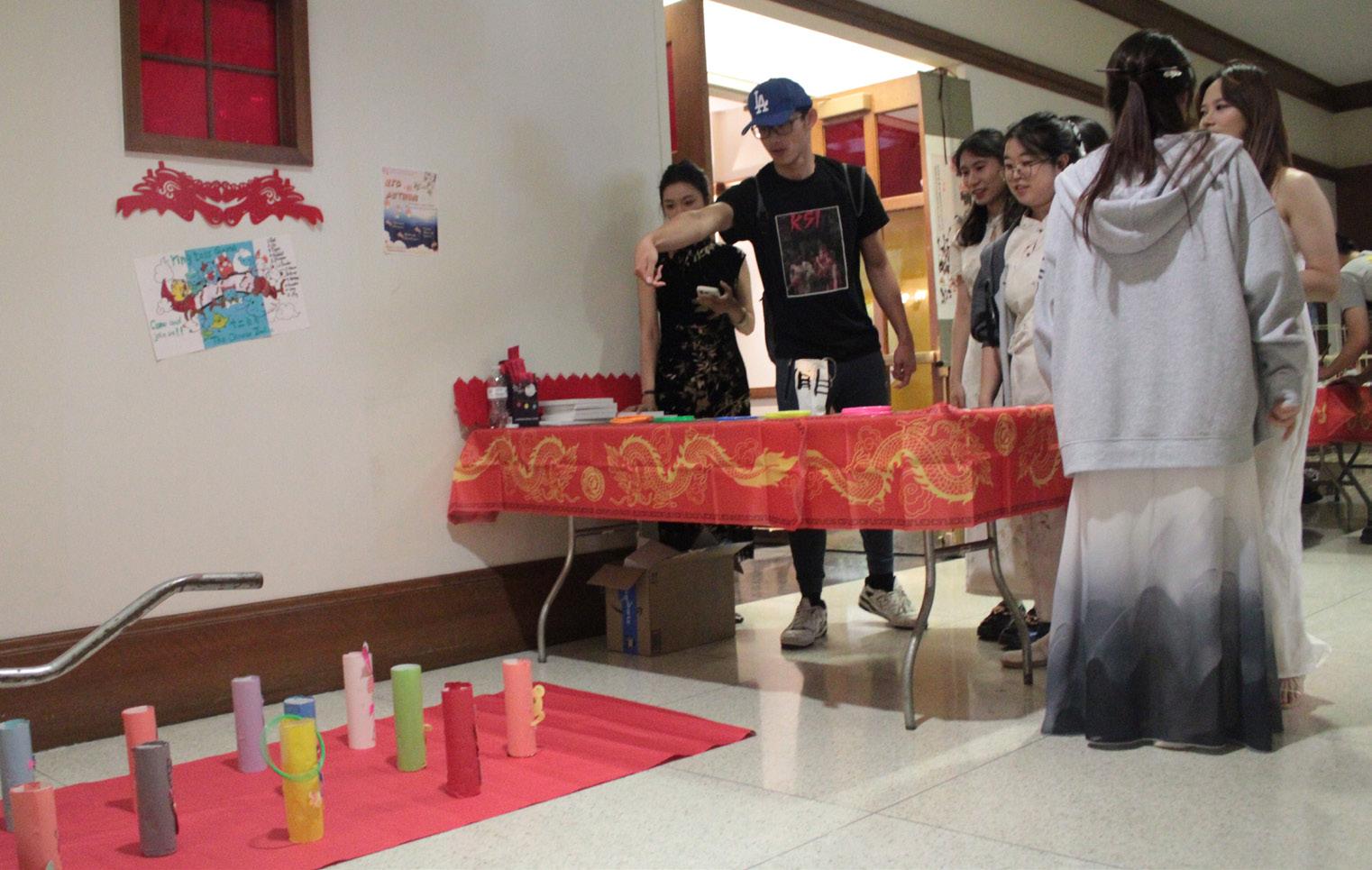
from this event is understanding the diversity and cultures
important to think about our own values and morals,
“What
better appreciate our backgrounds all together.”
Maluchluw said ASA events celebrate festivals from other Asian cultures, including Diwali, Korean movie nights and a Filipino celebration, halo-halo.
I hope for attendees to learn
in the world,” Maluchluw said. “It is
to
Bianca Brown ’27 has run SimplyB, her all-natural cosmetics buiness, since 2020. PHOTOS COURTESY OF BIANCA BROWN 27
Calvin Juwono ’27 (left) and Xuan Zhang ’25 (right) play a ring toss game at the Mid-Autumn Festival co-hosted by the Chinese Student and Scholar Association and the Asian Student Association.
PHOTO: SAHR KARIMU ’26/THE HAWK
On The Beat: ‘My Method Actor’
PARKER HAYDEN ’25
Special to the Hawk
Some albums can shape our outlook on music forever, having a hold over us throughout our lives and giving us meaning. Other albums exist on the outskirts of this range, acting as a diversion for the listener in their daily lives. These albums can be as great or as poor as any other album, but offer a listener the chance to enter a different world without making them give too much of their attention away. “My Method Actor” by Nilüfer Yanya is an album that does a great job of accomplishing this.
Yanya’s third album does something different while also doing something familiar. It is easy to digest and leaves you satisfied when you’re done listening. The track “Like I Say (I runaway)” is, at its core, a slow-burning song with a steady electronic drum beat. Once the chorus explodes, so do Yanya’s voice and a textured guitar, with the fuzziness of a shoegaze track bringing the listener into a position where they just have to nod their heads along. Yanya’s lyrics are also something to listen to, tackling the realization that time is valuable and how we use it matters.
“Faith’s Late” is another song with subdued instrumentation until the last minute or so where an orchestral section is added for a swelling crescendo. In this song, Yanya sings about facing identity when challenged with questions

that perplex our livelihoods. The most interesting track of the whole album is, in my opinion, “Just A Western,” as it changes the structure that previous songs have followed. Yanya lays down a country-inspired beat on the guitar while synthesizers swirl around the listener’s heads. The spacey production is an excellent example of mood-building in a song and emphasizes the power of a well-designed track.
“My Method Actor” is an excellent example of an album that is a nice getaway. After its 44-minute runtime, you’ll feel refreshed and ready to get on with your day. While it may not be the best album you’ve ever heard, it is a must-listen that does a great job of being a complex and fun release at the same time.
CROSSWORD: Primates in fiction
KUEBLER ’25
Assistant Features Editor

Down
Across
3 An inquisitive ape who travels with a man in a yellow hat
5. Like a lot of us, his first word was, “No!”
7 He started his career climbing a skyscraper. Now, he’s skyscraper-sized
8. A towering figure named for his purple hue
9. The mandrill who holds Simba up high in the iconic beginning scene of “The Lion King
10. Protagonist of the novel “Journey to the West” and the 2024 video game inspired by it.

1. Sang “Oh, oobee doo, I wanna be like you” in the Disney adaptation of “The Jungle Book ”
2. Dora’s sidekick named after his footwear
4 A telepathic villain from the DC comics
6 Famous for chucking barrels and wearing a tie with his initials
It’s a woman’s world
OLIVIA GASPARRO ’27 Features Columnist

The power of being a woman is unmatched. Through these songs, strength, resilience and confidence are powerfully conveyed to women, girls and all those seeking a sense of empowerment. Each track serves as a reminder of the countless capabilities those who identify as women possess, encouraging listeners to embrace their inner strengths.
“Who Says” – Selena Gomez & The Scene Selena Gomez & The Scene’s hit song “Who Says” delivers an empowering message to young listeners everywhere, encouraging them to stay true to themselves despite pressures from society. Released in 2011 as a part of their third studio album, “When The Sun Goes Down,” this song emphasizes the importance of self-acceptance and resilience. With a catchy melody and uplifting lyrics, the song serves as a reminder that everyone has unique, individual qualities worth celebrating. In the years since the song’s release, Gomez continues to inspire younger generations with a constant message to reject negativity and embrace their individuality.
“Man! I Feel Like A Woman!” – Shania Twain As one of the biggest women empowerment anthems of all time, Shania Twain’s “Man! I Feel Like A Woman!” is sure to get you on the dance floor. This upbeat, energetic song celebrates the strengths of being a woman, reminding us that sometimes the best way to empower ourselves and one another is to have fun. Whether singing in your car by yourself or dancing alongside friends, this anthem is a constant reminder of the power and freedom that accompanies being unapologetically yourself.
“Run The World (Girls)” – Beyoncé
“Run The World (Girls)” by Beyoncé powerfully vocalizes the theme of self-empowerment. With its memorable beat and powerful lyrics, the song celebrates the strength within all girls. Beyoncé’s dynamic vocals inspire listeners to recognize their worth and embrace their individual power, urging them to assert their dominance in a world that often attempts to undermine them.
“Girls Just Want to Have Fun” – Cyndi Lauper
If you like the 80s, wild hair and colorful outfits, this song is for you! “Girls Just Want to Have Fun” is a huge staple in pop culture, celebrating the freedom and fun of womanhood despite the judgment of others. Securing Lauper as a global pop star right from her debut, the song’s sparkling energy and luminous vocals joyfully brings together women of every decade.

GRAPHIC: STEPHANIE SAVELA ’25/THE HAWK
GRAPHIC: CARA HALLIGAN ’25/THE HAWK
GAVIN
Phillies look to carry regular season dominance
CHRIS SLETVOLD ’26 Columnist
The Philadelphia Phillies are gearing up for their third deep playoff run in as many years. As of Sept. 23, they are just behind the Los Angeles Dodgers for the best record in MLB. The Phillies have already clinched the National League (NL) East Division title with a 6-2 win over the Chicago Cubs Sept. 23.This marked the first time they clinched the NL East title since 2011.
The Phillies lineup is one of the deepest in the NL. Bryce Harper has been stellar this year. He leads the team in several offensive categories, including extra base hits, on-base plus slugging percentage (OPS) and total bases.
Lead-off man Kyle Schwarber evolved his game to incorporate more contact. His batting average has jumped over 50 points from last year, sitting at .250 as of Sept. 23.He is not sacrificing power, either; his on-base and slugging percentages are also up. Schwarber leads the team in walks and home runs. His approach will make him a difference-maker in October.
The rest of the lineup is still full of talent. Alec Bohm was an All-Star this year, pairing career-best batting splits with improved defense at third base. Trea Turner looked far more confident this season and returned to form. Brandon Marsh is still an above average hitter and elite defender.
The back end of the lineup has been less
effective than last season. Nick Castellanos hasbeenaverageatbestafterapoorstart.J.T. Realmuto has struggled with a knee injury. It has been a down year for Bryson Stott at the plate. The Phillies need production from these players in the playoffs if they want to returntotheWorldSeries.
Centerfield remains a question. Johan Rojas is still ineffective offensively. Struggling deadlineacquisitionAustinHays maynotevenmaketheplayoffrosterduetoa kidney infection. General manager Rob Thomson has tried outfield platoons in previous postseasons, so he may start the recent call-up Cal Stevenson againstrighties andRojasagainstlefties.
ThePhillies’startingpitchingstaffistheir biggest strength. Zack Wheeler, Cristopher Sanchez and Ranger Suárez were all All-Stars and posted career-best earned run averages (ERAs). Combined with longtime ace Aaron Nola, this is one of the best rotations in baseball. Expect these four starters to continue their dominance in the playoffs. If theycandoso,thebullpenwillthrive.
The relievers are the Phillies’ “X factor.” José Alvarado had a poor season and struggled to get strikeouts. Luckily, Jeff Hoffman,MattStrahmandOrionKerkering stepped up and posted elite ERAs. These three will take up the high-leverage relief innings.JoséRuizandmidseasonacquisition Carlos Estévez can step in if necessary. The Phillies’ bullpen lacks left-handers, however. Alvarado,StrahmandTannerBanksarethe

only reliable lefty relievers who are locks for the postseason roster. Alvarado finding his formwouldbesignificant. Still, the Phillies face stiff competition. The NL is chock full of contenders. The Dodgers, Milwaukee Brewers, Arizona Diamondbacks and San Diego Padres are all strong teams. It will be tough to even make the World Series, let alone win it over the New York Yankees, Baltimore Orioles or Cleveland Guardians of the American League. The Phillies stand a
good chance to make a run, though. They enter the postseason relatively healthy Their lineup is dangerous, especially if the bottom produces. The starting pitching is elite. The bullpen can win games if they’re not overworked. If all goes right, the Phillies have a real chance of winning their first World Series since 2008.

GRAPHIC: STEPHANIE SAVELA ’25/THE HAWK
GRAPHIC: STEPHANIE SAVELA ’25/THE HAWK

1939-40 football cardigan
JEFF SMITH ’26
Special to The Hawk
A sweater in the St. Joe’s Archives Collection is one of the few memorabilia left from the university’s short-lived football team.
The St. Joe’s football team officially began in 1922 and ended in 1939. According to historical accounts, they were never good, and student interest was low.
The sweater is a gray knit cardigan with two crimson lines across the sleeves. The buttons also have crimson details and a crimson lining, with pockets on each side. An emblem of a football with a large “St. J” inside is embroidered on the cardigan as well as the year of the team’s final season: “39-40.”
The sweater belonged to Joseph E. Monte ’42, a sophomore pursuing his bachelor of science in business in the team’s final season. According to the St. Joe’s Class of 1942 yearbook, he was a member of the team and was known for his athletic ability in football, basketball and intramural sports. He played as a back for the team, which, at the time, could have meant multiple positions on the field, essentially any position that is off the line of scrimmage on offense or defense.
From the start of the program, the team operated at a financial loss. Expensive equipment and low attendance added to the woes. In 1925-26, plans were created and some funds were raised to build a massive 70,000 to 80,000-seat stadium, but those never came to fruition.
Don DiJulia ’67, former athletics director of St. Joe’s and now an officer in university advancement, said there were never any serious discussions to bring back the football team. Every five to 10 years, the topic would come back up, he said, but due to the lack of infrastructure in place, it never came to be.
“We didn’t have locker space, office space, etcetera, so the infrastructure just didn’t lend to making that a comfortable, easy transition,” DiJulia said. “It was never a big deal.”
The legacy of the football team lives on, however, in the St Joe’s mascot, the Hawk.
According to various accounts, the mascot name came about, in part, because of the football team’s famous aerial attack. They threw the ball far more often than most football teams at that time.
None of those balls ever made it to the archives. But Monte’s sweater did.


GRAPHIC: MINDY CHOI ’25/THE HAWK
Joseph E. Monte’s ’42 cardigan from the 1939-1940 St. Joe’s football season, Sept. 23.
PHOTO: MADELINE WILLIAMS ’26/THE HAWK
GRAPHIC: CARA HALLIGAN ’25/THE HAWK
